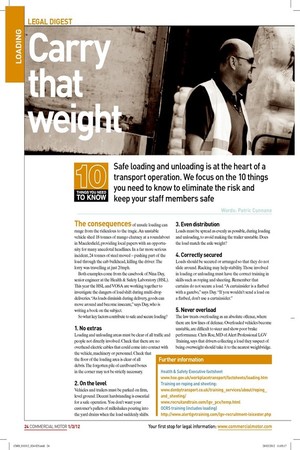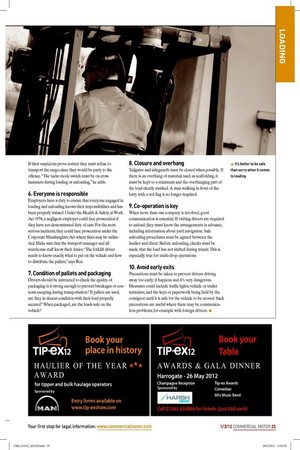Carry that weight
Page 18

Page 19

If you've noticed an error in this article please click here to report it so we can fix it.
Safe loading and unloading is at the heart of a transport operation. We focus on the 10 things you need to know to eliminate the risk and keep your staff members safe
Words: Patric Cunnane The consequences of unsafe loading can range from the ridiculous to the tragic. An unstable vehicle shed 18 tonnes of mango chutney at a roundabout in Macclesield, providing local papers with an opportunity for many anecdotal headlines. In a far more serious incident, 24 tonnes of steel moved – pushing part of the load through the cab bulkhead, killing the driver. The lorry was travelling at just 20mph.
Both examples come from the casebook of Nina Day, senior engineer at the Health & Safety Laboratory (HSL). This year the HSL and VOSA are working together to investigate the dangers of load shift during multi-drop deliveries. “As loads diminish during delivery, goods can move around and become insecure,” says Day, who is writing a book on the subject.
So what key factors contribute to safe and secure loading?
1. No extras 2. On the level
Vehicles and trailers must be parked on irm, level ground. Decent hardstanding is essential for a safe operation. You don’t want your customer’s pallets of milkshakes pouring into the yard drains when the load suddenly shifts.
3. Even distribution
Loads must be spread as evenly as possible, during loading and unloading, to avoid making the trailer unstable. Does the load match the axle weight?
4. Correctly secured
Loads should be secured or arranged so that they do not slide around. Racking may help stability. Those involved in loading or unloading must have the correct training in skills such as roping and sheeting. Remember that curtains do not secure a load. “A curtainsider is a latbed with a gazebo,” says Day. “If you wouldn’t send a load on a latbed, don’t use a curtainsider.”
5. Never overload
The law treats overloading as an absolute offence, where there are few lines of defence. Overloaded vehicles become unstable, are dificult to steer and show poor brake performance. Chris Roe, MD of Alert Professional LGV Training, says that drivers collecting a load they suspect of being overweight should take it to the nearest weighbridge. If their suspicions prove correct they must refuse to transport the cargo, since they would be party to the offence. “The tacho mode switch must be on cross hammers during loading or unloading,” he adds.
6. Everyone is responsible
Employers have a duty to ensure that everyone engaged in loading and unloading knows their responsibilities and has been properly trained. Under the Health & Safety at Work Act 1974, a negligent employer could face prosecution if they have not demonstrated duty of care. For the most serious incidents, they could face prosecution under the Corporate Manslaughter Act where ines may be unlimited. Make sure that the transport manager and all warehouse staff know their duties. “The forklift driver needs to know exactly what to put on the vehicle and how to distribute the pallets,” says Roe.
7. Condition of pallets and packaging
Drivers should be instructed to check the quality of packaging: is it strong enough to prevent breakages or contents escaping during transportation? If pallets are used, are they in decent condition with their load properly secured? When packaged, are the loads safe on the vehicle?
8. Closure and overhang
Tailgates and sideguards must be closed when possible. If there is an overhang of material, such as scaffolding, it must be kept to a minimum and the overhanging part of the load clearly marked. A man walking in front of the lorry with a red lag is no longer required.
9. Co-operation is key
When more than one company is involved, good communication is essential. If visiting drivers are required to unload, they must know the arrangements in advance, including information about yard navigation. Safe unloading procedures must be agreed between the haulier and client. Before unloading, checks must be made that the load has not shifted during transit. This is especially true for multi-drop operations.
10. Avoid early exits
Precautions must be taken to prevent drivers driving away too early: it happens and it’s very dangerous. Measures could include trafic lights; vehicle or trailer restraints; and the keys or paperwork being held by the consignor until it is safe for the vehicle to be moved. Such precautions are useful where there may be communication problems, for example with foreign drivers. n
Further information
Health & Safety Executive factsheet www.hse.gov.uk/workplacetransport/factsheets/loading.htm Training on roping and sheeting: www.denbytransport.co.uk/training_services/about/roping_ and_sheeting/ www.recruitandtrain.com/lgv_pcv/temp.html OCRS training (includes loading) http://www.alertlgvtraining.com/lgv-recruitment-leicester.php












































